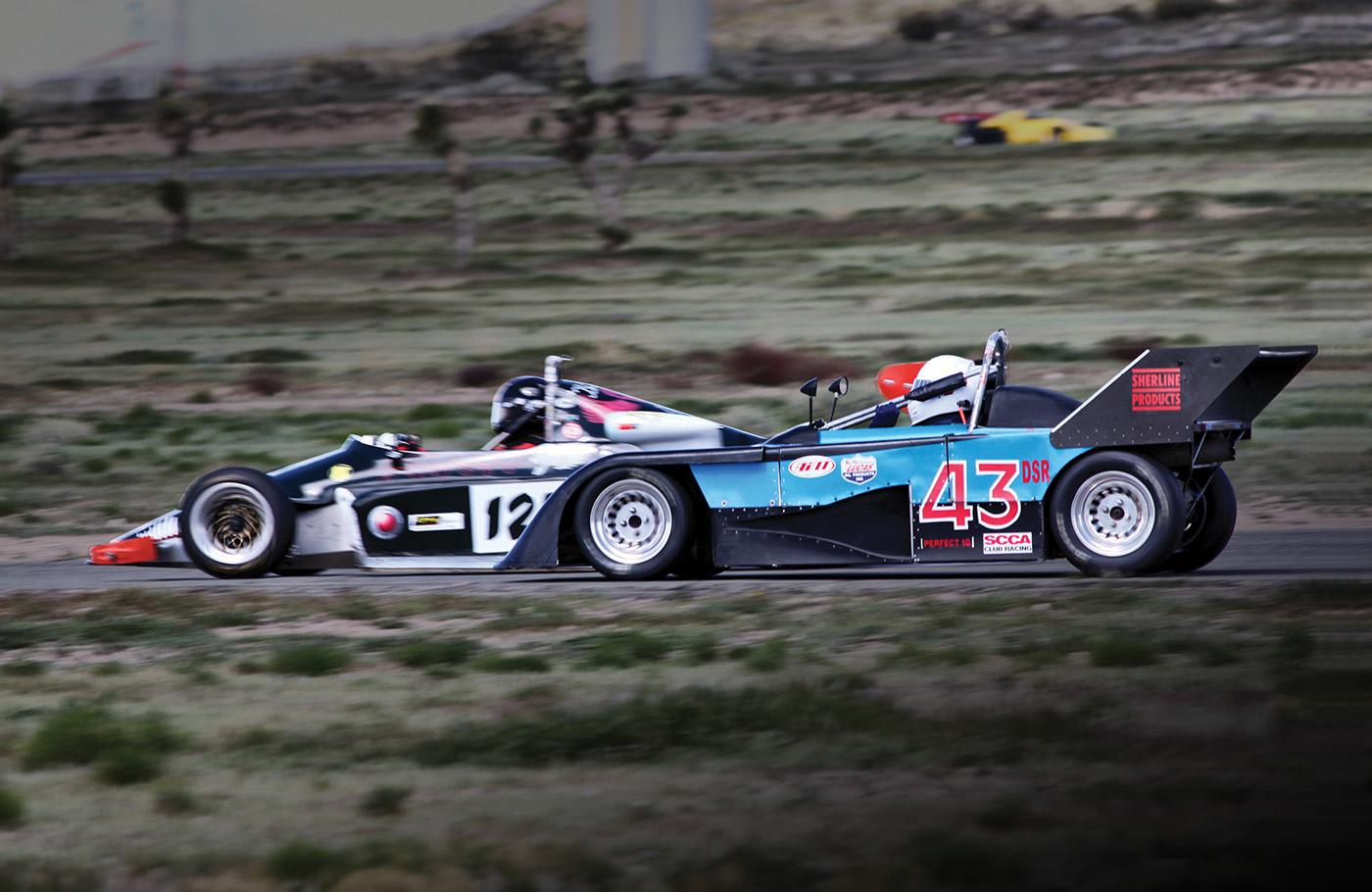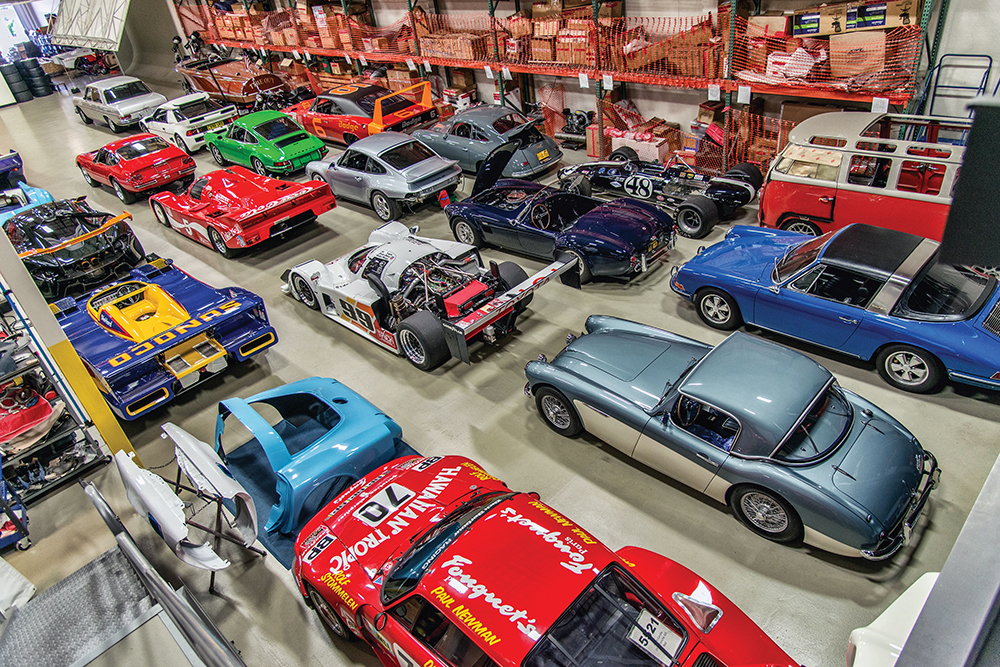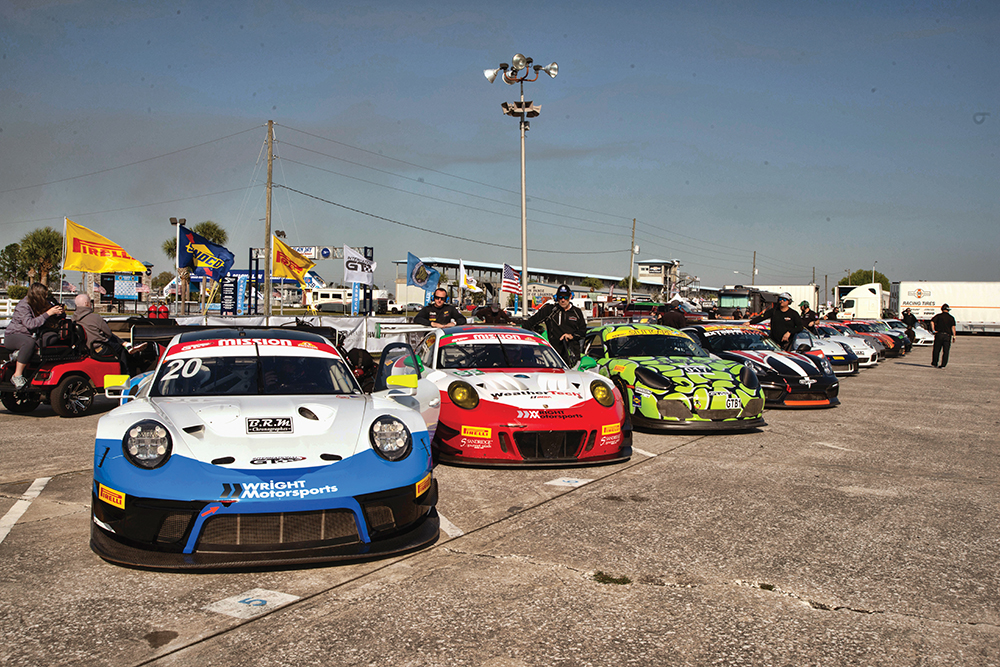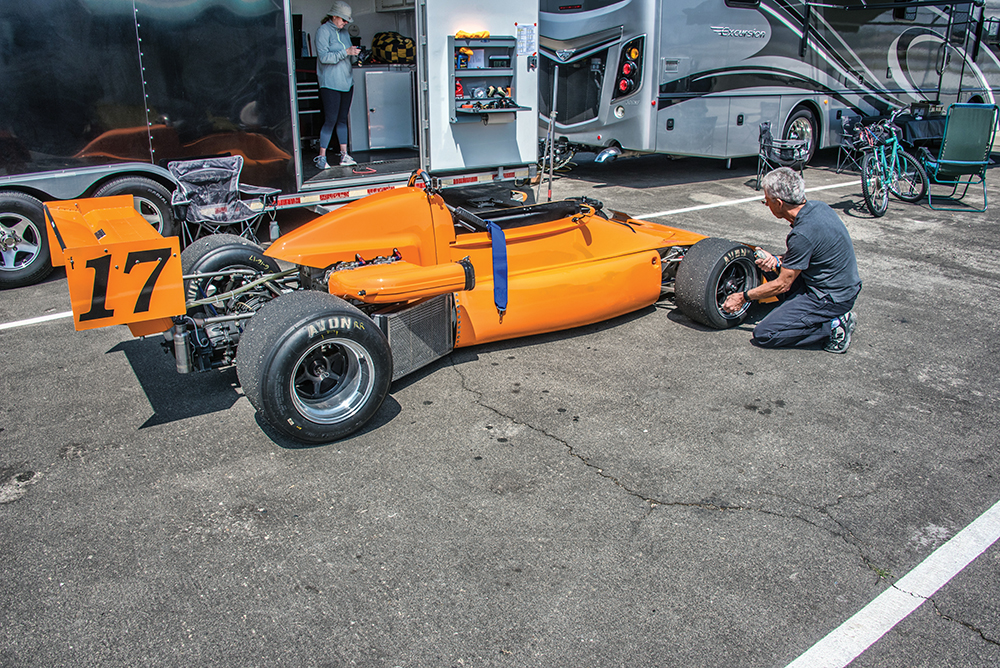THE NEW VINTAGE

Historic racing may celebrate the past, but that doesn’t mean it never changes. Quite the contrary, in fact, as our inside sources cite innovative solutions and approaches designed to stand the test of time.
Vintage racing is one of those sports that, whether wandering the pits or watching the action on track, can make fans feel like they’re frozen in time. Being surrounded by cars once piloted by the giants of racing, cars that mesmerized so many future fans during their formative years, has the effect of catapulting people back to earlier days where they’re happy to hang around awhile.
But time is definitely not frozen in the real world.
Time can’t, and doesn’t, stand still even for racing that celebrates the past. And vintage racing today is undergoing changes from several directions, some expected, some arriving out of left field. There’s the inevitable reevaluation of what counts as “vintage” as the calendar marches on. There’s the introduction of new technologies and new business models. And there are the short-term and long-term changes brought about by this year’s COVID-19 outbreak that will have an impact on all forms of racing.
TIME MARCHES ON
The perception of what qualifies as vintage, of course, is highly subjective. A car that appears “vintage” to a 30-year-old may remind a 60-year-old of a car he was driving seemingly only yesterday. Periodic updates are inevitable as one generation supplants another. Usually those changes begin very slowly, then accelerate quickly.
“We see it across the board. Whether it’s a street car or whether it’s a race car, we’re seeing it across the board,” said Bruce Canepa of Canepa Motorsport, Scotts Valley, California. Canepa Motorsport sells, services, and restores vintage racing machines. “In the last five years—it was in that small a window—people’s ideas of what an old car was went from a Pre-War car to the 1970s. Literally, it jumped 30 or 40 years, and it happened quickly. Part of it is, if you just look at the demographic of people that own the cars, race the cars, people that drive them on the road, if you look back, you say, ‘A 1970s car is an old car. I mean, it’s 50 years old.’”

Vintage racing organizations have their fingers on the pulse of the market and have seen the evolution firsthand. The Vintage Racer Group is one such. “When VRG started, the cutoff date for production cars was 1972. So about 10 years ago we said, ‘You know what? We need to start getting some younger people involved, because we don’t want this to become just a ‘silver only’ club,” said Jim Karamanis. “When you do that, you age out and you’ve got no one to drive the cars. As much as I love cars from the early 1970s, someone that graduated from high school 20 years after me—I graduated in 1990, so 2010—they don’t know what a 1972 B-Sedan Pinto is; to them, that is just something that they heard explodes.”
The Sportscar Vintage Racing Association (SVRA) in Southlake, Texas, has been particularly aggressive about expanding eligibility for vintage motorsports. “We constantly change every year. Our rule of thumb is five years or older,” said Tony Parella. “Theoretically, 2015 cars can run with us in different classes. The older classes have stayed still, but we’ve added and expanded the newer classes. We added Miatas in a separate class, a race group, a few years ago with the Heritage Cup program to bring in younger kids and remove some of the high-cost barriers to go racing.
“We’ve evolved since I’ve owned SVRA in 2012,” Parella said. “We instilled a rule, five years or older, that we would create a class for your car, a race group for your car. That served us well. A lot of the groups were anything newer than 1972 [and] they wouldn’t do it. Well, that’s not what we are. We’re a national racing organization and we feel that’s too wide a gap to run at the places we run.”
Besides just the natural changing of the generational guard, there are solid practical reasons to expand eligibility for newer cars. “Over the last five years we’ve done a couple more updates,” said the VRG’s Karamanis. “Two or three years ago we moved the production date from 1979 to 1989. And this past year, we changed the rules to also allow IT (Improved Touring) cars from 1979 to 1993. What that does is it lets you allow cars that might not necessarily require a fuel cell, because once you start getting into more modern technology of the 1980s, cars are designed to crunch—they’re not the rigid things that the cars of the 1950s, 1960s and 1970s were.” Being able to run a stock fuel system is one less obstacle to clear for drivers to get a car on track.
“We had racers coming to us and saying, ‘I don’t want to put a fuel cell in this car,” Karamanis said. “My car’s designed to crumble. I’d have to build a cage there. Is that safer than my car crumbling and absorbing the impact?’”
Car count is another practical necessity that favors adding newer-generation vehicles. “It’s not cheap to rent a race track, I don’t care if you do it on a Wednesday or Thursday through Sunday,” said Don Hoevel from Don Hoevel Racing, Fox Lake, Illinois. “Car count still pays the bills, for one. And that makes perfect sense. And the demographics—I’m 60, and none of us are getting any younger. And most of my customers are 60 and older. I’ve got a couple of guys that are 45 to 55. Myself, I grew up in the 1960s, and Boss 302 Mustangs, Z28s, that was the king of the hill. The people that are 10, 15, 20 years younger than me, they didn’t live through that.”
Hoevel reported steady business at his shop, everything from 1960s Can Am racers to a 2009 Porsche Cup car. “I don’t see historic racing going away, it’s just changing,” he said. “You look at all the LMP cars, and all that stuff coming in, it makes perfect sense. I mean, you’ve got that stuff laying around. They’re obsolete cars in the current classes, so why leave them laying around? Car count is paying the bills.”
Expanding eligibility has helped expand the field at the Monterey Motorsports Reunion. Bruce Canepa serves on the selection committee, and he said that he has long pushed for inclusion of an IMSA 1973–1981 group, which eventually came to pass. “Today, that class is oversubscribed by 50-plus percent. We’ll get, for a 40-car field, 65 or 70 cars easily. We have to pare that back to a manageable amount for on-track. And that really affords you the opportunity to pick the most important, famous, recognizable cars that ever raced in the event, whether it’s an Interscope 935 or a Momo car, or this Corvette or that Ferrari.
“We’ve also added a newer class, which is the IMSA GTO, and Trans-Am tube-frame cars, and GTP Group C cars,” he continued. “Those cars in different parts of the world ran together. They were different classes, but they ran together. So we have a class, it’s prototypes, starting in 1982, like the first March, up through 1990–1991, which includes all the GTP cars up through the Toyota GTP cars, Nissans and Jaguars, of course 962s in between. In that class there’ll be 20 of those cars, and there’ll be another 20 IMSA GTO kind of cars like Roush ran with Tommy Kendall, and like Scott Pruett drove, because those are now old cars to people. They look at them and remember seeing those cars race.”

Another practical advantage of including tube-frame Trans-Am and IMSA cars is that they are sturdy machines, to say the least. Most were engineered to withstand the rigors of endurance racing. “What we see there, the old Group 6 was the Camaros and the Corvettes, and the Mustangs, the 1960s and 1970s,” Hoevel said. “A lot of those guys had those cars. Those cars are huge maintenance. To drive them well and drive them fast, those cars are a lot of maintenance. Then all of a sudden you get one or two guys getting into these tube frame cars, and it’s a whole lot easier to drive one of those cars. You’re six or eight or 10 seconds faster than what you’re driving your 1965 Corvette. There’s a big transition from the Group 6 guys into the Group 9 class with all the tube-frame cars, and all the semi-modern Trans-Am and GTO sports cars. Group 6 has dwindled, and Group 9 has gotten big.”
Individual race shops are also seeing the shift in vintage racing interest. “It’s hard to get people into some of the older vintage stuff,” said Ryan Hayes of RaceKraft & Design, Englewood, Colorado. “That’s why Miatas are so popular. Shoot, all you have to do is add gas and check tire pressure all weekend, and it’s a bulletproof car. I consider the Miata the bugeye Sprite of the day.”
At Michael’s Vintage Racing in Hopewell Junction, New York, they’ve also witnessed interest in newer vintage cars. “I’d say the cars we’re starting to see that are a little bit newer, some of the weird and cool stuff, kind of some 1970s-era Celicas, pseudo-sedan type stuff like that, which is cool,” said Mike Clifford Jr. “We’re seeing E30 BMWs, first- and second-generation RX-7s. There are a couple guys running early Golf GTIs, which is kind of fun.”
Clifford also appreciates that the newer cars are sometimes easier to find parts for than the much older vintage models he usually deals with. “We have a 510 and a 260Z here, and it’s nice to be able to just order stuff sometimes,” he said, laughing. “Most of our stuff is a process.”
Of course, newer vintage race cars aren’t always easier to put together. One stumbling block to widespread acceptance is the difficulty in finding obsolete electronics packages. “What people don’t realize is the availability of the electronics,” said Hoevel. “As the cars started going to electronics, it’s getting more and more difficult to get functional black boxes, ECUs and things like that. It’s not impossible, and there are ways to outfit the car with different systems, but everybody doesn’t quite understand that when they go to buy this stuff straightaway.”
The Business Plan
Besides the newer cars on track, vintage racing is also evolving thanks to new business models and new opportunities.
Parella Motorsports Holdings, owner of SVRA, is also majority owner of the Trans Am presented by Pirelli Series, and has been aggressive in pairing the two together for common events.
“When we bought SVRA it was only running at three race tracks. We run at 14 now. We’re national in scope,” said Parella. “We invested in the Trans Am race series, a professional series, so that enabled us to put on a show that we could market to race fans to sell tickets. We could attract sponsors, but we also could leverage the vintage side of things for luxury brands and race-related brands, and now the collection of both we’re starting to market to consumer brands,” he said.
“Our strategy, it’s not just vintage, it’s not just Trans Am—the two together really give us a unique show. I’m marching us toward mainstream motorsports in this country.”

The combination of vintage and current racing in the same race weekend is paying off in ways that benefit vintage racers. “The proof in the business strategy is simple,” Parella said. “If you look at SVRA in 2012, 100 cents on the dollar came on the backs of the racer in two forms, either a license revenue or entry revenue. There were no spectators and there were no sponsors.”
According to Parella, as of 2019, SVRA is 30 times bigger than it was in 2012. “But more important than that, over 50 percent of our revenue comes from sponsorship and gate,” he stated. “Over half. So we’re 30 times bigger because we expanded to 14 events from three different venues, but the real growth came on top of that from the mix that has changed from sponsorship and gate.”
Some specialized sectors of vintage racing are seeing new opportunities that haven’t existed before to get cars on the track.
“We’ve been doing a lot of 1980s and early 1990s Indy cars,” said Hoevel. “When I worked at Newman/Haas, I started working there in 1986; in 1987, we won Long Beach with Mario Andretti. We just finished restoring that car for Zak Brown at McLaren, and that got shipped off to him right before Christmas. I’ve got another 1992 Danny Sullivan Long Beach winner here. Somebody else did the major end of the restoration and we’re just finishing up.”
Hoevel sees interest rising for Indy cars from the 1980s and 1990s. “There’s a pretty good demand for that right now, because they’ve started to get a little bit more organized,” he said. “There’s probably four or five semi-organized events for old Indy cars right now, and it’s a little bit different than our normal vintage racing. You can actually vintage race them if you want to, but the vintage Indy events are, you show up and you run two or three times a day in conjunction with, like, the Indy 500 or the St. Louis IndyCar race. It’s a lot of guys that have probably been race fans for all their life. They’re in their late 40s, 50s, 60s, 70s. Some of these guys have probably acquired these cars 20 and 30 years ago, and they’ve sat in the corner of the barn or whatever. Now there seems to be pretty good interest because there are places to go out and run these things. And you don’t have to race them, but you can drive them.”
FEVER DREAMS
When we interviewed our sources for this article, it was mid-April and the coronavirus disruption had shut down much of the motorsports industry. There’s no way to know exactly how that will all play out as 2020 rolls on, but in the short term, at least, vintage racing will be adapting just like every other form of motorsports.
“Any way you look at it, our events are going to be different when we go back,” said Hoevel. “The July race at Elkhart Lake, they’ve got the Friday night parade into town, and you end up in town with 10,000 people looking at the race cars. Well, that’s not going to happen.”
The Vintage Racer Group has added one of the popular racing adaptations to keep interest simmering. “We’ve done things a little different this year to try to give people some excitement and something to feel happy about, because honestly, this has been a really depressing time, for people not just worried about racing, but family and friends. So we started a virtual iRacing series for our club members,” said Karamanis.
He reported that the organization is getting some buzz on social media, and it’s not just younger members interested in virtual racing. “In the practice session last night, we had all ages and all kinds of experience, both between the virtual world and the real world,” Karamanis explained. “We had an 18-year-old kid win the race last night. I bet if you counted the laps he has on the real track and put it against everyone else out there, it’s probably a blip on the radar. We’ve had guys up into their mid-70s that were racing last night, and I’ve got guys up almost into their 80s coming out next week.”
The SVRA also has an e-racing deal in the works. They’ve spent considerable time formulating plans for when race tracks do reopen. “We’re spending a lot of our time adjusting to when we do come back out to race, to make sure we’re prepared for the new normal, whatever the new normal is going to be,” said Parella. “And that largely has to do with how do we put on events, and social distance, and keep social distancing a focus point. Because I don’t believe it’s going to magically, in two weeks or three weeks, be okay to come out and revert back to what we once considered normal.”
At press time, the SVRA’s most likely next events were scheduled for June, with one at Indianapolis Motor Speedway and one at Mid-Ohio. “All of our focus right now, over the last six weeks, has been reinventing our processes,” Parella said. “As an example, registration, we’ve got it down to just a waiver that people sign, and I’m trying to get that where we can do that with DocuSign.
“Our registration team will have masks, they’ll have gloves, they’ll have a glass shield. We’re going to a different type of wristband,” he continued. “We’ll have, in the goodie bag, we’ll have a mask for the driver, hand sanitizer, and their own unique pen, if I don’t get the DocuSign signed.”
The social aspects of the race are still up in the air. “We used to have huge Saturday night parties, as we’re so much focused on the social moment, but no parties for the foreseeable future until social distancing is not needed,” Parella said. “Our victory circle will look different. Our tech inspection will look different. Our driver meetings are going to be done with Zoom so we don’t have to have everyone congregate. So we’re thinking in those terms. From a fan standpoint, the neat thing about vintage racing, or Trans Am, or road course racing, is you don’t have an assigned seat typically. We’re kind of like going to the drive-in movies instead of going to the theater. You can spread out and still watch the race.”
The fan experience will still be familiar, if a bit different. Parella said they are working on producing a digital event program for download instead of the traditional paper program, and food vendors will be more spread out.
“Our goal, our whole mantra in every conference call with my team, is ‘I want you to make our races safer than going to the grocery store.’ That’s the mission,” Parella said. “Clearly there’s a pent-up demand. People are getting a little goofy sitting in the house this long, me included. But I want to make sure we do it right and don’t look like we’re not being socially responsible.”
“I’m super optimistic that when it does open up, the floodgates are going to open and it’s going to be super healthy and everybody is going to be ready to go racing,” added Brandi Kaiser of K-Hill Motorsports, Abbottstown, Pennsylvania.
Undoubtedly, those first few laps back on track after the layoff will be ones to remember, no matter the vintage of the car.
 MEMBERSHIP LOGIN
MEMBERSHIP LOGIN JOIN PRI
JOIN PRI


